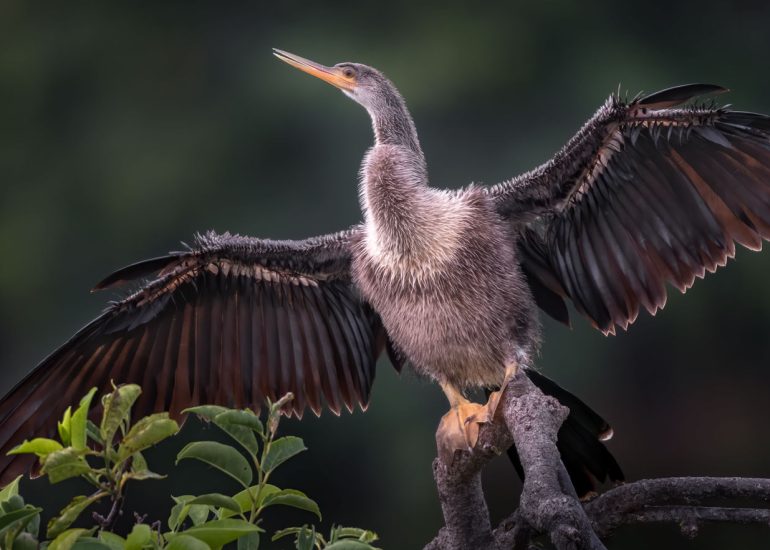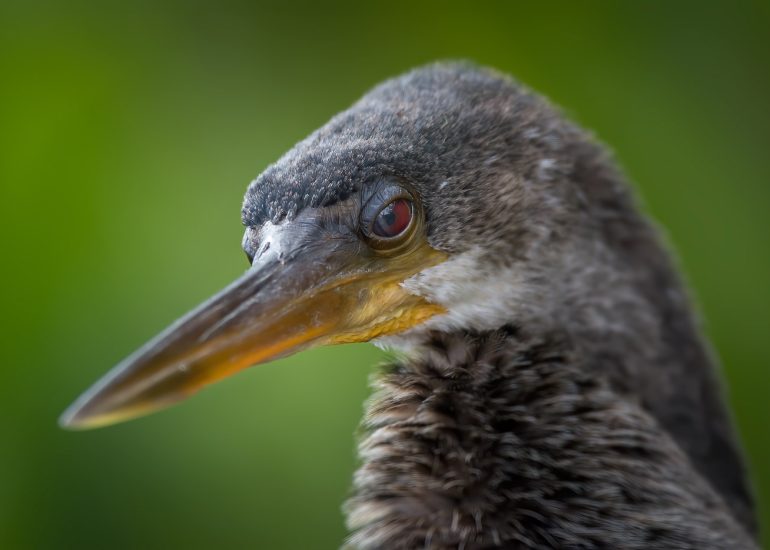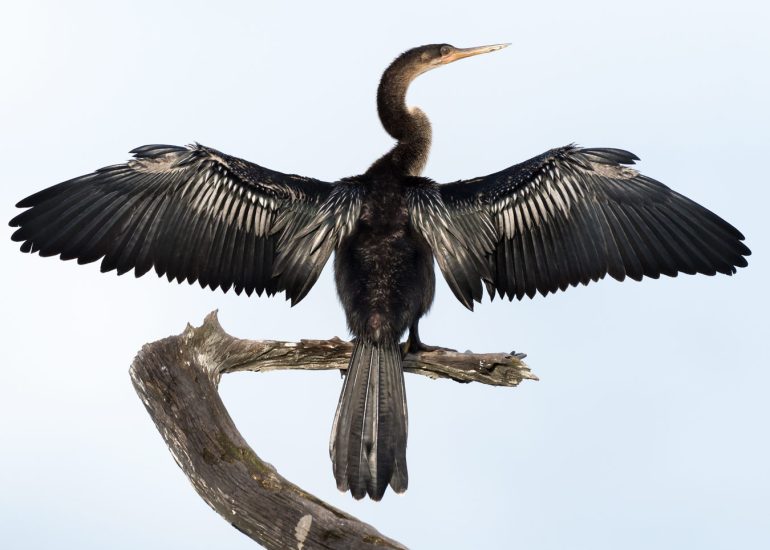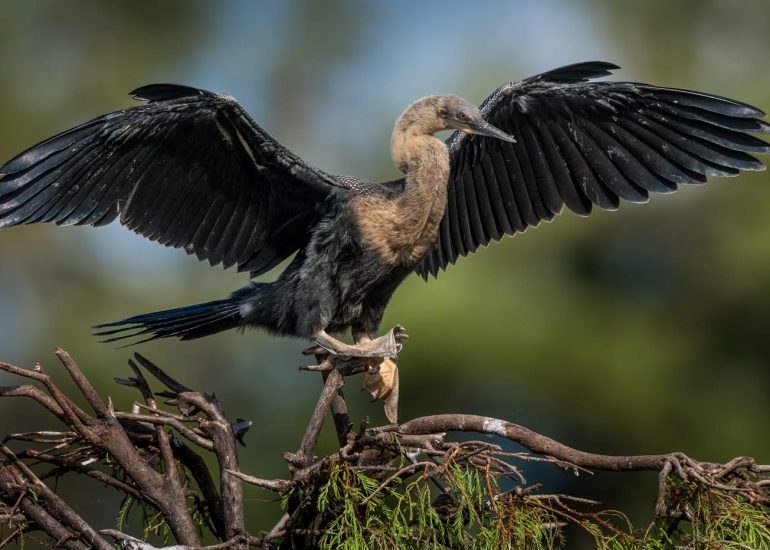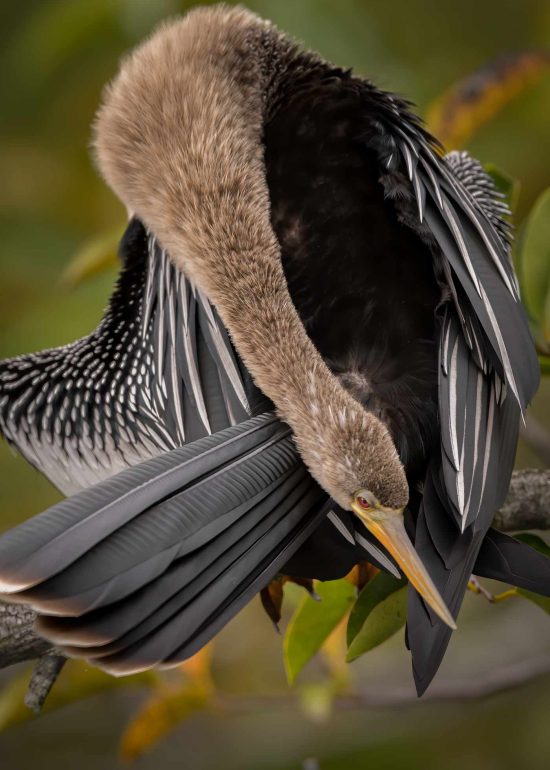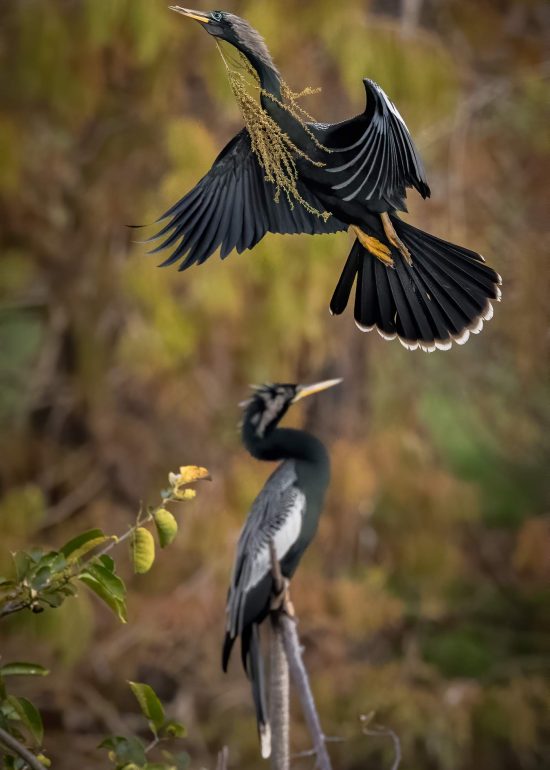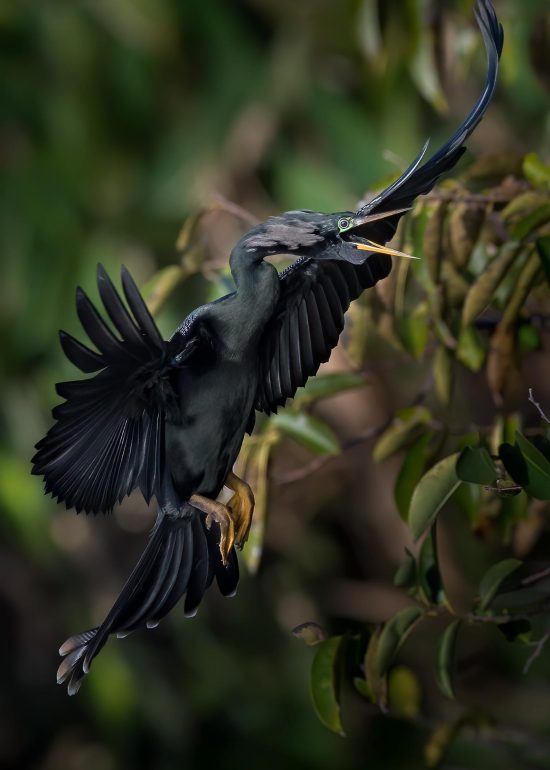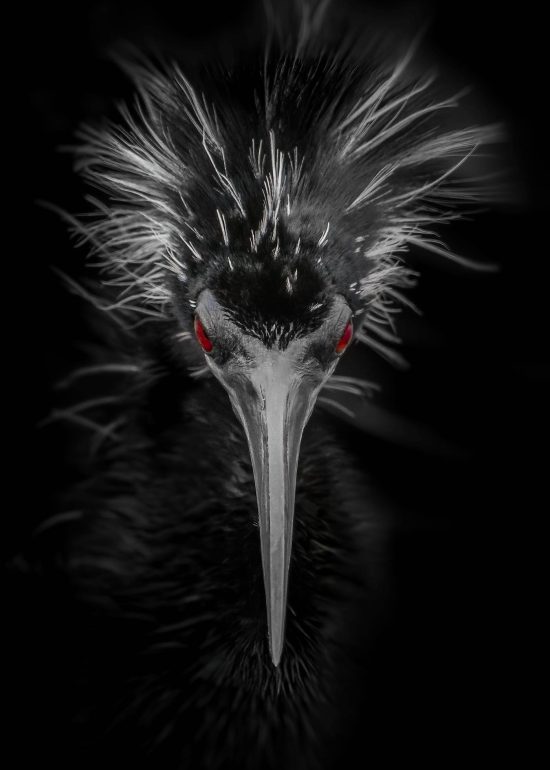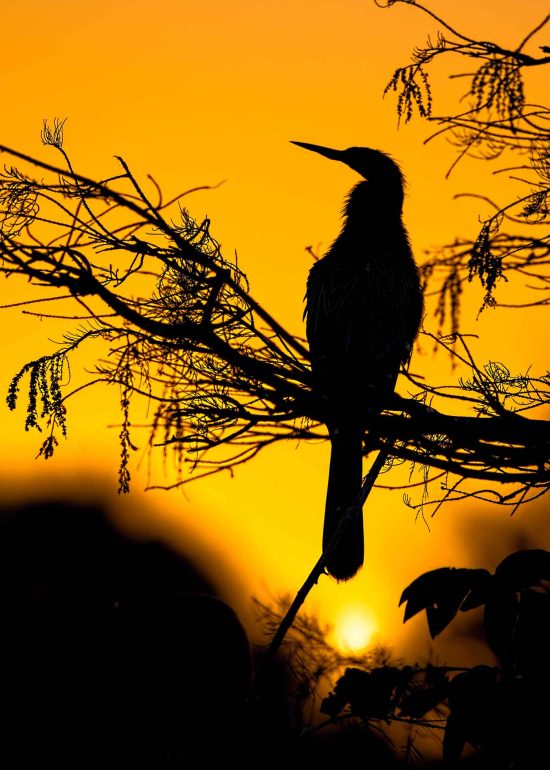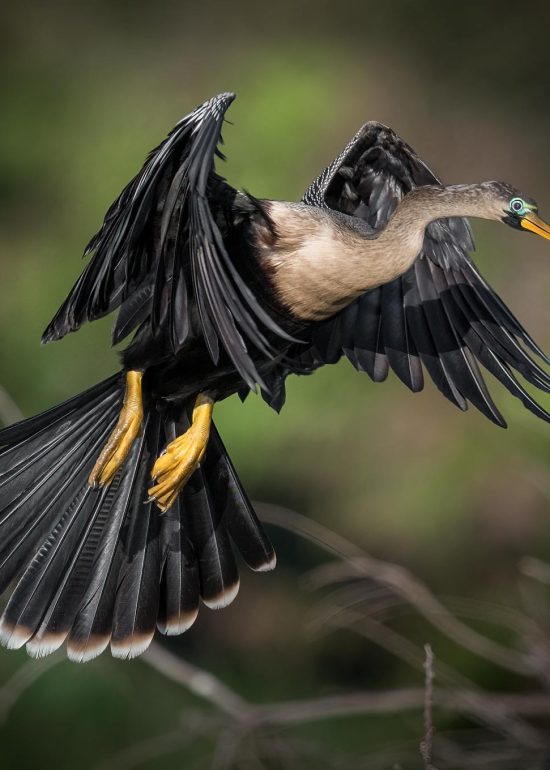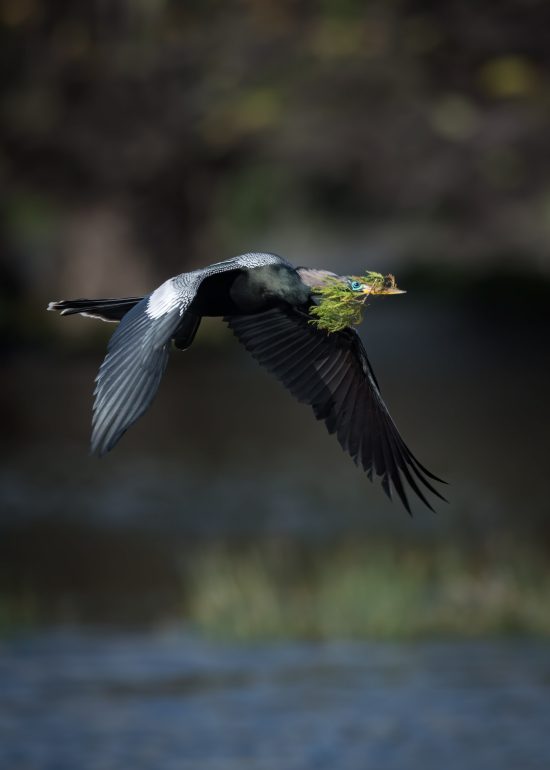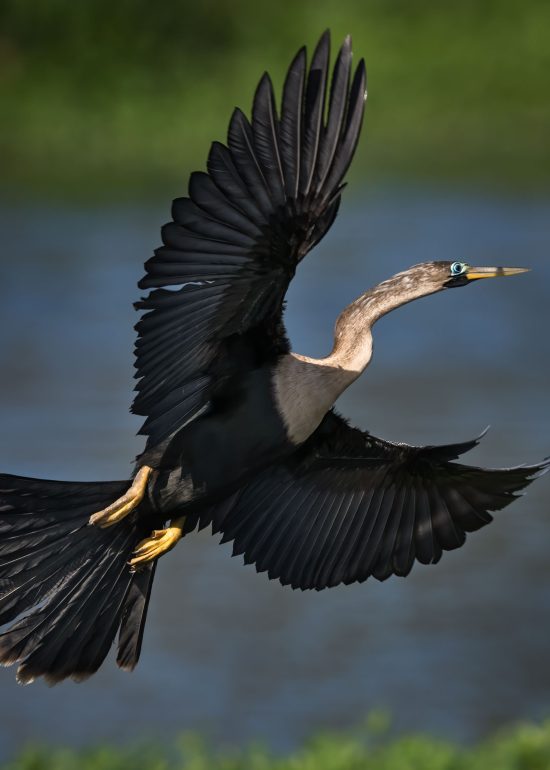The Anhinga

If you’ve ever visited the swamps, wetlands, or mangroves in and around the Florida Everglades, there’s a chance you’ve seen one of these stealthy, snake-like waterbirds gliding through shallow marshes. Known as the “snakebird”, the “water turkey”, the “darter”, and the “American darter”, the Anhinga (Anhinga anhinga) has rightfully earned each one of these titles. The ability to swim under water and rapidly spear fish with their sharp pointed bills are just a few of the unique characteristics that make Anhingas some of the most entertaining birds to photograph. I also find them to be quite interactive and chatty, never missing an opportunity to croak-up a conversation with me. It’s funny really; their interactions remind me of my cats—perhaps another reason I’m so fond of them.
Commonly confused with the Double-crested Cormorant, Anhingas are one of the most misidentified bird species in North America. But fear not! Of course I’m going to tell you everything you need to know about these multi-talented aviators to prepare you for your next South Florida wildlife adventure. You’ll also get to see some of my most captivating Anhinga pictures, so you’d best buckle up—let’s fly.
Meet the Anhinga
- Scientific Name: Anhinga anhinga
- Order: Suliformes
- Family: Anhingidae
- Conservation Status: Low concern
- Size & Wingspan: 30 to 36 inches tall; 3.7-ft wingspan
- Lifespan: 12 years





Identification
Like the Great Blue Heron and many other bird species, Anhingas are native to South Florida. Excellent swimmers and fliers, these big, lean-bodied, aquatic birds have lengthy fan-like tail feathers similar to a turkey. Their thin necks are long, S-shaped, and attached to a relatively long daggerlike beak with reddish eyes. They’re generally quiet, making clicking sounds that resemble a croaking frog only when around their nesting site.
The plumage of Anhingas differ between sex and age. Adult males have greenish-black necks and heads, white, silvery, gray-streaked upper backs, and flight feathers trimmed in a chestnut color that fades into long white plumes. The back of their heads and necks sport lengthy feathers that are an elegant shade of light lavender gray.
 Females on the other hand are brown and black bodied with a pale beige upper head, chest, and neck. Young anhingas are born naked but grow into their beigy colored down two weeks after birth. At about three weeks, juveniles start to develop a creamy white plumage that darkens as they mature and eventually grow into their dark bodies and white, silvery markings. All sexes share golden, yellow-colored webbed feet, legs, and beaks—although the female bills are slightly lighter than males. During breeding season, Anhingas dawn a bright blue color around their lores. Ah, the beauty and complexity of nature, it gets me every time.
Females on the other hand are brown and black bodied with a pale beige upper head, chest, and neck. Young anhingas are born naked but grow into their beigy colored down two weeks after birth. At about three weeks, juveniles start to develop a creamy white plumage that darkens as they mature and eventually grow into their dark bodies and white, silvery markings. All sexes share golden, yellow-colored webbed feet, legs, and beaks—although the female bills are slightly lighter than males. During breeding season, Anhingas dawn a bright blue color around their lores. Ah, the beauty and complexity of nature, it gets me every time.
As for their size, the average Anhinga weighs approximately two to three pounds, and is around 33 inches long, with a wingspan of nearly four feet. Their heads are small, appearing to be just an extension of their curiously long necks.
Flight and Swimming Mannerisms
An Anhinga begins flight by diving from tree limbs or sprinting in shallow pools. While flying it holds its wings flat with its neck and tail sticking straight out, almost resembling a soaring cross. When swimming, they float like a wet blanket—wings fanned and a soggy turkey-like tail bobbing behind them out of the water. Their buoyancy varies so their heads and necks stick out above the water, which gives them the illusive appearance of a snake or as some say, the infamous Loch Ness Monster.
When returning to the water, Anhingas simply glide from their sunny perch or they crawl back in from land.
Different Than Other Waterbirds
Unlike most other waterbirds, Anhingas lack the preen oil glands that waterproof their feathers and so they must constantly dry themselves off. If not, I suspect they’d eventually become waterlogged and drown. So, while other aquatic birds such as ducks can easily dive under the water and return to the surface without a problem, the Anhinga cannot. This regal water turkey has to dry its plumage and regulate its body temperature after each dip, making catching prey on the first try all the more important. But, while it may seem counterproductive for their water-loving lifestyle, the Anhingas’ dense bone structure coupled with their wet feathers allows them to gently go under the water so they can covertly stalk fish with ease.
 After every plunge into the water, the Anhinga strikes a triumphant pose on the fringes of shallow shores with its head held high and its shiny gray wings half expanded to dry and re-fluff its feathers. After that, it’s time to soar! Or go back into the water to find another snack…
After every plunge into the water, the Anhinga strikes a triumphant pose on the fringes of shallow shores with its head held high and its shiny gray wings half expanded to dry and re-fluff its feathers. After that, it’s time to soar! Or go back into the water to find another snack…
Habitat
Typically spotted during the day, Anhingas, like Great Egrets, are diurnal and tend to feed alone, but are sometimes with herons, cormorants, storks, and ibises. You’ll find them year-round in South Florida, Mexico, coastal South Carolina, and Texas, as well as in the warmer areas of Central and South America, often inhabiting places with less open waters like shallow rivers, wooded, slow-moving Cypress swamps, lagoons, ponds, lakes, mangroves, and inlets where dead trees and snags are present.

When in the water, these strategic spear fishers spend the majority of their time hunting for food. When out of the water, it’s common to find them roosting high up in nearby trees sunbathing their beautiful shimmery wing plumage. Because Anhingas don’t have a layer of feathers on their body that give them adequate insulation, they lose heat rapidly in the water. The heat from the sun is what helps them preserve and regulate their body temperature, making South Florida’s subtropical climate just what the doctor ordered.
Where to See Anhingas
If you want to see one for yourself, the forested wetlands of the Everglades are an excellent place to start, particularly the Anhinga Trail. As I mentioned above, these birds tend to populate shallow, forested areas with lots of tree cover and branches to perch and sun on. The sawgrass marshes offer the perfect place for them to fish, live, and breed.
Look for a stealthy dark body swimming through areas of shallow fresh and brackish waters with only a head and partial neck out. What you thought was a water snake, could actually be an Anhinga. If you aren’t able to catch a glimpse of one roaming the waterways, look up at surrounding trees. In the afternoon, these sun-lovers are easy to spot hanging on branches, basking in the sweet Florida heat.
Wanting to witness an Anhinga in flight? Even though they’re waterbirds, they’re also pretty darn good at flying, often seen soaring through the sky, riding on heat pockets called ‘thermals’, much like Ospreys and other raptor-like birds. If what you see looks like a flying cross, you’ve likely spotted an Anhinga.









Behavior and Feeding
For the bird paparazzi community, catching an Anhinga in the act of feeding is exciting. Animated hunters, Anhingas are piscivores and forage for fish both on the surface of water or by swimming underneath and scouring the foliage below.
While they aren’t the fastest swimmers, they are brilliant stalkers. These avians take off by diving from the limb of a tree or by sprinting on shallow water. Unlike the Double-crested Cormorant that catches fish in its serrated beak and eats them underwater, Anhingas quickly dart and impale fish directly in the heart with their long and slightly opened daggerlike bills. Once they’ve captured prey, they typically head for land to eat, tossing the fish in the air right before swallowing it whole and headfirst, although sometimes it takes a couple tries to get it right. It sounds kind of gross I know—but it makes for the best pictures!
An Anhinga’s diet consists mainly of small to medium-sized wetland fish, specifically fish that people don’t normally eat like blue gill, mullet, sucker, pickerel, catfish, and gizzard shad. They also dine on shrimp, water insects, crayfish, leeches, frog eggs, and occasionally baby alligators, small turtles, and yes, even snakes.
Nesting and Displays
Anhingas definitely aren’t loners. They tend to live in large groups of mixed bird colonies with cormorants, ibises, and herons; rarely do they nest in single pairs. When an Anhinga does find a partner, they mate for life.
 As with many bird species, the male chooses a nesting site and begins to put on passionate dance-like courting displays of soaring to the nest from high altitudes, wing waving, tail raising, skyward beak pointing, and the charming low bow—all to attract his female partner. He puts maximum effort into his movements to make the best impression—after all, she’ll be responsible for constructing their nest with all the materials he so ardently finds.
As with many bird species, the male chooses a nesting site and begins to put on passionate dance-like courting displays of soaring to the nest from high altitudes, wing waving, tail raising, skyward beak pointing, and the charming low bow—all to attract his female partner. He puts maximum effort into his movements to make the best impression—after all, she’ll be responsible for constructing their nest with all the materials he so ardently finds.
An Anhinga nest is typically found in trees 4-feet to 20-feet above the water. They consist of a compact and cumbersome base of sticks that’s softened inside by a lining of twigs, green foliage, catkins, and willow tree leaves. For years after the initial nest construction, they’ll continue to build it out. On occasion, Anhingas can be bullies and will take a nest currently occupied by an egret or heron.
Territorial Displays
 Like Wood Storks, Anhingas are exceptionally territorial and will employ fierce and melodramatic displays of aggression when defending their home site. This includes fanning their wings wide to assert dominance and clacking their beaks. These displays have been known to lead to pecking fights, with each bird feverishly attacking the other’s crown and neck until one surrenders and leaves.
Like Wood Storks, Anhingas are exceptionally territorial and will employ fierce and melodramatic displays of aggression when defending their home site. This includes fanning their wings wide to assert dominance and clacking their beaks. These displays have been known to lead to pecking fights, with each bird feverishly attacking the other’s crown and neck until one surrenders and leaves.
Eggs, Parenting, and Juvenile Maturation
Breeding Anhingas typically lay two to five eggs in a clutch, with an average brood of four eggs a season. Oddly shaped with one pointed end and colored a light teal blue that’s glazed with a chalk-like coating, the eggs are relatively small, measuring at around two inches in length and about 1.5 inches in width.
The incubation period of Anhinga eggs lasts about a month and both parents lovingly take on the responsibility of keeping them warm and feeding them once they’ve hatched. For about three weeks, they stay in the nest. However, at approximately two weeks old, startled babies will jump out of their bed of sticks and leaves to the water below. Most of the time it’s not an issue as they are fully capable of climbing back up to the nest using the talons on their webbed feet as well as their beak for support.
At six weeks old, young Anhingas dawn their flight feathers, but they won’t be completely independent of mom and dad until the reach full maturity—typically around two years old.

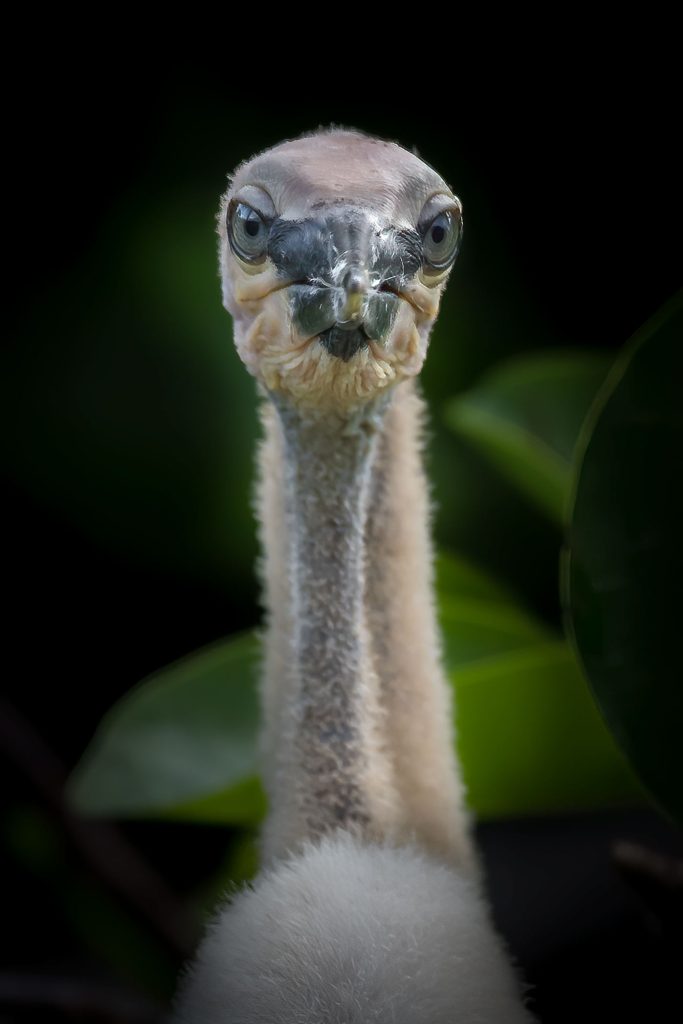

Life Cycle
The average lifespan of Anhingas is about 12 years, but there are reports of them living in the wild to be as old as 16. When it comes to predators and staying alive, the Anhinga has more to worry about than fellow wildlife eating its young. In certain parts of the world, primarily Asia, humans customarily eat Anhingas and their eggs.
Of course, these birds have their fair share of natural predators too. Hawks, ravens, crocodiles, and alligators make meals out of these aquatic hunters as they’re easy targets when they’re young or submerged under water.
South Florida Anhinga Photography at the Dan Power Gallery
Over the several years I’ve spent taking pictures of wildlife in and around South Florida, the Anhinga easily makes my list of top five favorite birds. With their cat-like personalities and unique mannerisms, honestly, what’s not to love?
For more images of South Florida wildlife, check out the Dan Power Gallery, where I regularly post pictures of my bird watching escapades. And if you like what you see, everything is available for purchase in the Dan Power Gallery online store.


